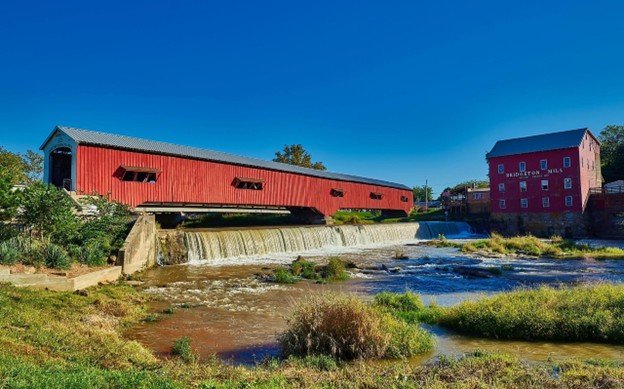Let me take you on a journey to a town where history grinds on—literally. Bridgeton, Indiana, is a place where you can watch 19th-century technology turn grain into pancake mix and still have time for ice cream and antique shopping. If you’re into charming red bridges, waterfalls, stone-ground flour, and the kind of small-town energy that says “We rebuilt it because we could,” then friend, you’re in for a treat.
This sleepy hamlet in Parke County may be home to just a few full-time residents, but don’t let that fool you. Come October, the place swells with festival-goers like cornbread rising in a cast iron skillet. But even if you visit in the off-season, Bridgeton offers a slice of Americana that’s too delicious to skip. Linda and I grew up near this amazing little town and spent many hours in there during the annual Parke County Covered Bridge Festival.
Let’s cross that iconic red bridge (at a walk, please!) and uncover the stories behind Bridgeton’s plucky past and its community of modern-day pioneers.
A Town Once Called Sodom (Yes, Really)
Bridgeton’s history begins in the early 1800s, a time when Indiana was more wilderness than welcome mat. The first settlers called the area Lockwood Mills. Then, due to some rowdy behavior—think too many late-night whiskey-fueled debates on horse trading—it got the unfortunate nickname “Sodom
On Saturday’s and public days, the mill became the community social center. People exchanged gossip and conducted business while buying gallons of whiskey at twenty-five cents apiece. Those townsmen would engage in horse races and (not surprisingly) sometimes fights. As you can imagine, that didn’t go over great on postcards.
Eventually, someone had the good sense to rename it Bridgeton, a much more respectable name that also reflects its lovely (and legal) covered bridge. The town’s location along Big Raccoon Creek made it ideal for milling and mischief. By mid-century, the town boasted shops, a schoolhouse, a doctor’s office, and enough sandstone buildings to make any stonemason proud.
Today, Bridgeton still feels like stepping into a living diorama—only with snacks. Every time Linda and I visit it, I keep wondering what life would be like living there during its early years.
The Grist Mill That Keeps on Grinding
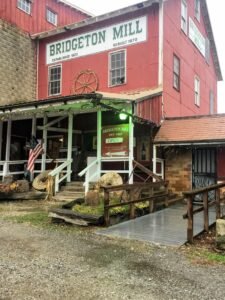
Ah, the Bridgeton Mill. Built in 1823, burned in 1869, rebuilt in 1871 (you’ll notice a theme here), and still grinding away like your grandma’s opinion on modern music. This place has survived fire, neglect, and a dust explosion, and it’s still producing stone-ground flour the old-fashioned way—with enormous French Buhr stones (several thousand pounds of them and all over 200 years old), and a whole lot of charm.
Back in its heyday, the mill powered the town’s economy and even lit up the local homes. Then came the 1950s, a time when Elvis was king and flour was industrialized. The mill was nearly forgotten—until Mike and Karen Roe bought it in the ‘90s and decided, “You know what this town needs? Fresh cornmeal.”
They restored the mill by hand, piece by piece. Today, you can tour the facility, hear the delightful rumble of antique gears, and buy pancake mix that tastes like something Laura Ingalls Wilder would approve of.
A Bridge, a Blaze, and a Comeback Story
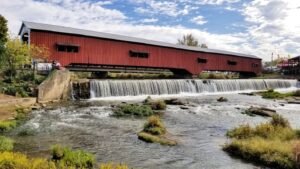
The covered bridge in Bridgeton isn’t just photogenic—it’s heroic. Originally built in 1868 by J.J. Daniels, it spanned 261 feet of picturesque creek and was painted a red so vibrant it practically winked at you.
Then, in 2005, someone decided to burn it down. (Why? We don’t know. Maybe they hated history. Or bridges. Or happiness.) But the people of Bridgeton weren’t about to let that be the end of the story. Within a year, volunteers and local craftsmen rebuilt the bridge using the original blueprints and more determination than a kid building a Lego castle.
The new bridge opened in 2006, and it’s just as beautiful—and just as stern about crossing at a walk. Inside, you’ll find initials, inscriptions, and the occasional love note carved into its wooden ribs. It’s not just a bridge; it’s a memory box with a roof.
Historic Buildings with Personality
Bridgeton’s historic district isn’t the kind of place where you’ll find velvet ropes or “Do Not Touch” signs. These 19th-century buildings are alive with activity—and sass.
- The 1878 House: This Victorian beauty once belonged to some local bigwigs and now serves as a gift shop filled with trinkets, crafts, and that old-house smell you didn’t know you missed.
- The Case Log Cabin (1822): You want authenticity? How about an actual log cabin where people demonstrate pioneer crafts during festivals. Bonus: there’s usually someone playing dulcimer on the porch like it’s 1835 and TikTok hasn’t been invented.
- The Country Store (1868): Still serving up nostalgia, along with kettle corn and locally made crafts. Step inside and pretend you need to pick up some molasses and a tin of buttons.
- Dr. Crooks’ Office & Masonic Lodge: Once a place for check-ups and secret handshakes, this building now hosts art and gifts. From leeches to landscapes—it’s had a glow-up.
Even outside of festival season, these buildings whisper stories. All you have to do is lean in and listen—or buy a hand-sewn potholder.
Festival Season and Bridgeton’s Big Moment
Come October, Bridgeton sheds its sleepy village vibes and turns into the Jewel of Parke County. The Covered Bridge Festival brings over a million visitors to the area, and Bridgeton is one of the main attractions. It’s like a historical Renaissance Fair with better parking.
You’ll find:
- Rows of tents packed with antiques, soaps, woodworking, jams, quilts, and more crafts than most people can think of. On one of our trips to the festival several years ago, I bought a leather Australian Cattleman’s Hat that I still have. Hoarder? No, just hanging on to the past.
- Pioneer re-enactors making soap, playing dulcimer, and churning butter like it’s a competitive sport.
- The mill in full swing, with the smell of fresh flour and cinnamon-spiced things wafting through the air.
- The covered bridge acting like the town’s selfie booth—everyone wants their picture taken with it.
And if you visit outside the festival? Lucky you. You get a quieter Bridgeton: no lines, no crowds, just you and a town that’s still doing its thing.
The locals are always up for a chat, and if you ask nicely, they might even share the secret to the best cornmeal pancakes you’ve ever had.

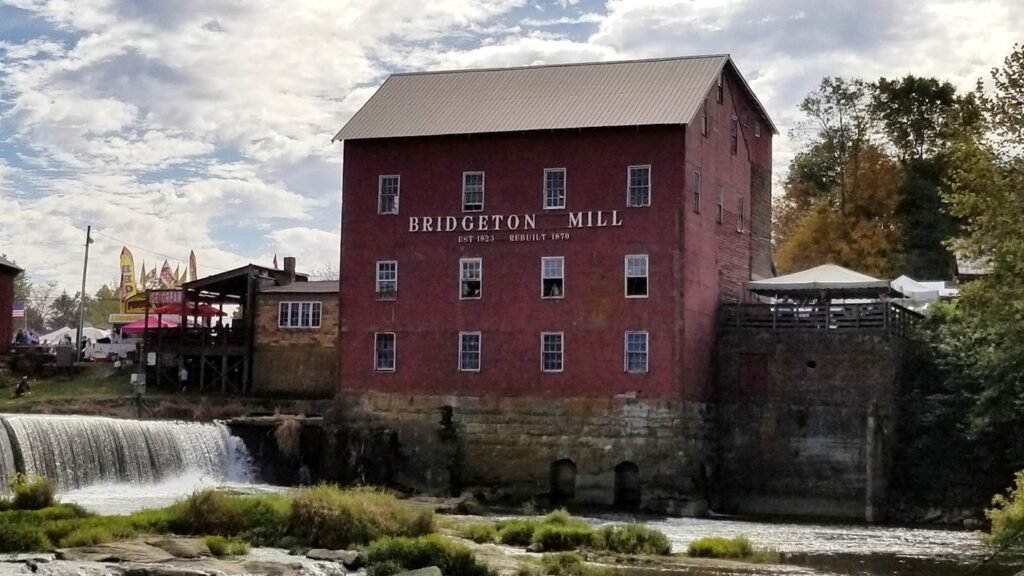
Final Thoughts: Bridgeton Is Proof That Small Is Mighty
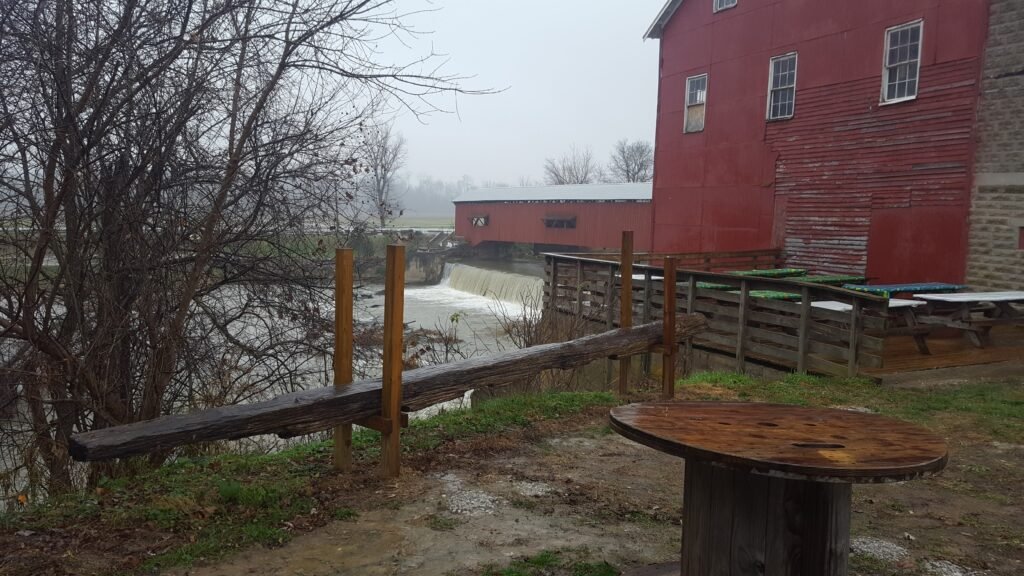
Bridgeton isn’t just a destination—it’s a vibe. It’s where history is hands-on, the food is handmade, and every creaky board and spinning gear reminds you that the past is still very much present.
So pack your walking shoes, bring a hearty appetite (for stories and snacks), and don’t forget your camera. Because this little Indiana town has a big story to tell—and it’s still being written, one stone-ground bag of cornmeal at a time.
Helpful Links for Visitors:
- Bridgeton Mill Products & Hours
- Parke County Covered Bridge Festival Info
- Bridgeton, Indiana – Wikipedia
- Fire destroys historic covered bridge (WTHR-TV, April 27, 2005)
- GPS Address: 8134 Bridgeton Rd, Bridgeton, IN 47836
- Open Seasonally (April–December): Check individual shops for hours
Free Day Trip Checklist
Click the button below to download a free copy of my Day-Trip Checklist

Mike & Linda: Exploring the world’s forgotten, hidden, historic wonders. Join their journey as they share tales, tips, and timeless travel moments.
